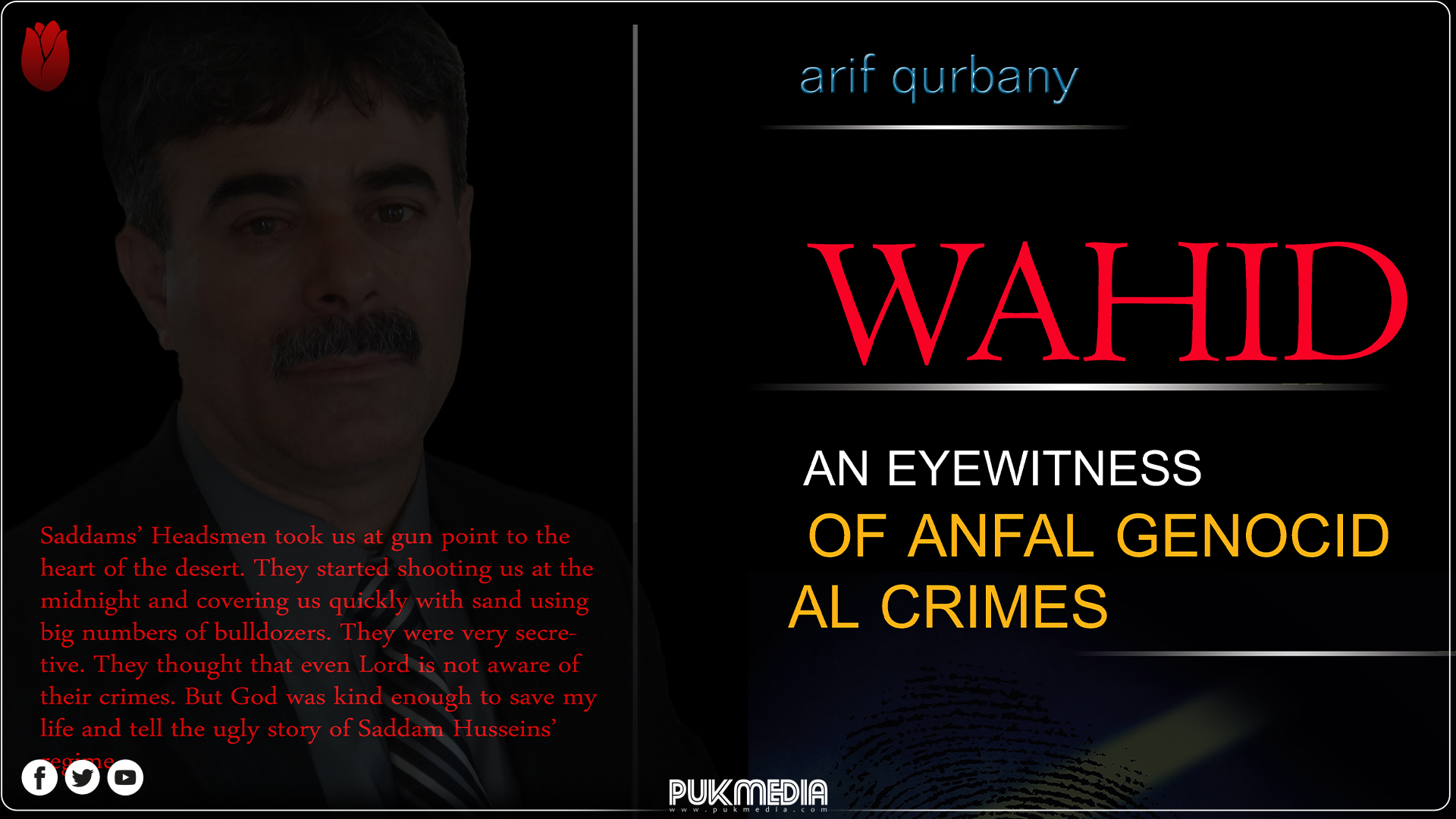Wahid: An Eyewitness of Anfal Genocidal Crimes
Genocide 03:49 PM - 2021-11-01
'Wahid: An Eyewitness of Anfal Genocidal Crimes' is one of the Kurdish writer Arif Qurbany's collection of books on the genocide of the Kurds by the notorious Baath regime.
The book has been translated to English by the Kurdish writer and academic Abdulkarim Uzeri.
On his journey to look for information, documents, and evidence to write his book on the Anfal Campaign, Arif Qurbany came across a man who has witnessed almost all the atrocities that happened to the Kurds.
The man's name is Wahid Muhammad Kochani. Kochani is the eye-witness and the survivor of Anfal genocidal crimes committed against the Kurds.
Kochani, along with the other survivals of the mass graves, was taken to the United States. During the Anfal campaign, Kochani was taken from his remote village in the south of Chamchamal city to a concentration camp called Topzawa not very far from the oil-rich city of Kirkuk, he saw tens of thousands of Kurdish children, women and men gathered at gun point in that horrible camp. Within hours males aged from 15 to 70 years were separated, put into sealed transporters and taken to the firing squad fields of Ar-Ar desert west of the capital Baghdad.
The Anfal victims were taken in special transporters without ventilation or a drop of water to drink. Although the trip took about twelve hours but there was no access to the rest room at all. And when they arrived the death pits the systematic shooting started and the only way for victims to survive was to attack the headsmen with their bare hands taking the last chance to stay alive. Most of the survivals could save their lives by executing such heroic challenges against armed men of the Iraqi regime, including our hero Wahid Muhammad.
The Baath regime's campaigns against the Kurdish people were numerous and included a wide range of crimes.
The campaigns started with the Arabization of inhabited areas in the southern part of Kurdistan including Kirkuk city and several towns like Khanaqin, Makhmur, and Shengal. The original Kurdish inhabitants were forced out of their homes without being allowed to take their basic necessities, while the Arabs who occupied these houses received them for free, over and above the fact that they had already been given cash as an inducement to reside in Kurdistan.
In 1983, eight thousand young men were rounded up at gunpoint and taken to some unknown destinations in the south of Iraq. Thereafter, they all disappeared, and even foreign diplomatic efforts have failed to trace a single person.
Reports from Iraqi military sources indicate that they were used as guinea pigs to test the effects of various chemical agents.
Another horrific feature of the Iraqi campaign was the regime's resorting to chemical weapons against civilian populations!
On April 16, 1987, a chemical attack on the Balisan valley near Erbil killed dozens of civilians. On March 16, 1988, a sustained chemical attack was launched on Halabja, where roughly 5 thousand civilians died and many more thousands were seriously injured.
The largest genocide committed against the Iraqi Kurds by Saddam Hussein's regime was in 1988 which was one of the most systematic mass killings.
Although 182,000 victims have been documented, there are tens of thousands of victims who have not been recorded: the unnamed newborn infants, the unborn children of pregnant mothers, the many people who were shot and killed by the infantry and the air force as they escaped on foot and those who died by starvation and diseases.
The author dedicated his book to Peter Galbraith who made Americans aware of genocides against Kurds.
Tap here to read the full book...
PUKmedia
More news
-
Supreme Alawite Council Condemns Repressive Practices in Aleppo
08:32 PM - 2026-01-08 -
Kurdish Media Figures and Institutions Criticise Al Jazeera’s Coverage of Events in Syria
06:07 PM - 2026-01-08 -
U.S. Seizes Russian-Flagged Tanker, Another Tied to Venezuela
10:14 AM - 2026-01-08 -
Oil Prices Rise After U.S. Inventory Draw, Venezuela in Focus
09:59 AM - 2026-01-08
see more

World 11:09 PM - 2026-01-08 U.S. Envoy: Syria’s New Chapter is One of Cooperation, Not Confrontation
SDF Commander Warns Attacks in Aleppo Undermine Negotiations and Endanger Civilians
10:15 PM - 2026-01-08
Italy Provide Medical Aid to Sulaymaniyah Health Directorate
03:16 PM - 2026-01-08
Israel Condemns Syrian Government 'Attacks Against Kurdish Minority' In Aleppo
11:20 AM - 2026-01-08
Iraqi President and First Lady Attend Cyprus EU Council Presidency Opening Ceremony
12:01 AM - 2026-01-08
Most read
-
Israel Condemns Syrian Government 'Attacks Against Kurdish Minority' In Aleppo
World 11:20 AM - 2026-01-08 -
Kurdish Media Figures and Institutions Criticise Al Jazeera’s Coverage of Events in Syria
Kurdistan 06:07 PM - 2026-01-08 -
Italy Provide Medical Aid to Sulaymaniyah Health Directorate
Kurdistan 03:16 PM - 2026-01-08 -
Oil Prices Rise After U.S. Inventory Draw, Venezuela in Focus
News 09:59 AM - 2026-01-08 -
U.S. Envoy: Syria’s New Chapter is One of Cooperation, Not Confrontation
World 11:09 PM - 2026-01-08 -
U.S. Seizes Russian-Flagged Tanker, Another Tied to Venezuela
News 10:14 AM - 2026-01-08 -
SDF Commander Warns Attacks in Aleppo Undermine Negotiations and Endanger Civilians
Kurdistan 10:15 PM - 2026-01-08 -
Supreme Alawite Council Condemns Repressive Practices in Aleppo
World 08:32 PM - 2026-01-08






 Application
Application


